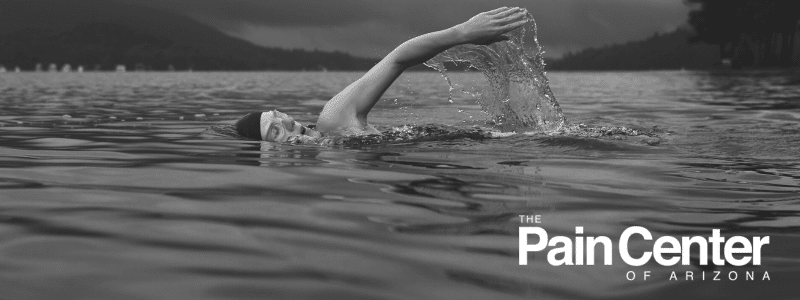
As summer approaches, more families are heading to the pool to cool off. It is also a time when many who suffer from a wide range of pain conditions take advantage of the pool to help ease their pain. But does swimming actually help reduce degenerative disc disease pain? There is a bit of a debate within the chronic pain community about this exact question. Some argue swimming can worsen back pain, while others say swimming is a safe form of exercise for degenerative disc disease.
Our pain management doctors often recommend exercise to help relieve degenerative disc pain. Light and low-impact exercise can help increase blood flow to the spine, strengthen the muscles that support the spine, and even help patients keep off additional weight. High-impact exercises, like running or jumping, may cause a great deal of pain because damaged discs cannot absorb shock as well on hard surfaces. Swimming solves this problem because our spines don’t have to work as hard to support our bodies. The buoyancy of water eliminates the stress that is usually absorbed by the joints during exercise.
For this reason, patients with degenerative disc disease may find pain relief from doing light stretches or exercises in the pool. Backstroke is often recommended because it promotes a neutral spine and reduces the risk of hyperextension associated with other swim strokes. Those who are not ready for swimming may opt to try water aerobics, which can help strengthen the core and lower back muscles.
In some cases, however, swimming may be harmful to degenerative disc disease and other back or spine conditions. Patients unfamiliar with the breaststroke may accidentally throw the head back too far, and those doing a front stroke requiring them to look to the side for breath may hurt their necks as well. Patients who want to try swimming for degenerative disc pain should first consult with their doctor and consider working with a certified trainer or physical therapist before trying any of the exercises on their own.
If you are cleared to swim, start with spine-friendly swim techniques and stretches that you are already familiar with – and go slow. Take care to use proper technique, and try to keep your body straight and avoid twisting the spine. Floatation devices can be used to help avoid hyperextension in your back or neck, as you are less tempted to move into an irregular position to stay afloat.
Through activities like swimming and aqua therapy, you can beat the heat and feel better too. If you are experiencing degenerative disc disease pain or other back pain, talk to your physician or a board-certified pain management specialist for more tips to relieve your back pain.


